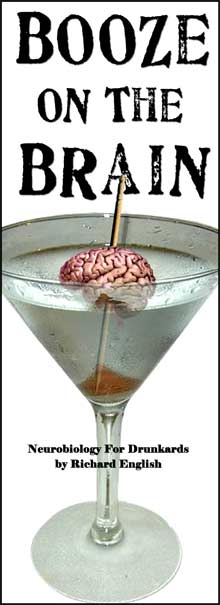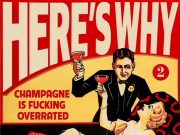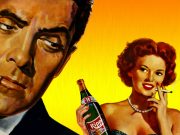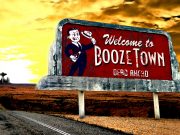 Intoxication causes horrific damage to the entire community, or so say members of the prohibitionist movement across the globe.
Intoxication causes horrific damage to the entire community, or so say members of the prohibitionist movement across the globe.
From MADD, to Islamic totalitarians, to jabbering Pentecostals (who apparently see no harm in rattlesnake venom), prohibitionists tell us that alcohol injures and kills not only innocent bystanders, but the drinkers themselves. While it is a lamentable fact that people are occasionally killed by drunken motorists, the odds of it happening to a given individual are relatively small. But to hear the prohibbies talk, you’d think the nation’s highways and byways positively teem with sozzled drivers who careen through decent society giddily unaware of the death and mayhem they leave behind.
Prohibbies sometimes put forth pronouncements concerning the health of individual drinkers. Drinkers are, as is obvious from the tone of the announcements, less important to society than are “innocent” victims – unless you’re talking about squeaky-clean white college students who seem to occupy a special strata of victimhood all their own. Prohibbies would have us believe that even a single molecule of alcohol can mutate us into lurking sociopaths who spend our days giving head for shots of Mad Dog and trolling for squeaky-clean white college students to harass and/or otherwise ejaculate upon.
To support their pious fright-mongering, prohibbies claim to have facts working for them, and, furthermore, that said facts are based on rigorous scientific analysis.
It’s generally a mistake to let twitchy nerds get their paws on statistical data.
The numbers tend to undergo treatment in a partisan pressure cooker, and remain there until they can do nothing but support a given hypothesis. And yet, the post-treatment figures somehow manage (bafflingly) to retain every ounce of their scientific weight, and thus seem to dazzle with the Light of Truth. When enough “facts” are collected and cooked, they are then pretzled into an ominous Slinky of Doom, and marched down the stairs (alone and in pairs) for the sole, and grossly dangerous, purpose of instilling fear in the general populace. Such activity is, obviously, a fine example of how to misuse science.
Across the many branches of science, some theories are so well researched and documented that only fundamentalist chuckleheads, and tenure-bloated, postmodernist, gasbags fuss over them. Some of the standouts are, evolution through natural selection, the special theory of relativity, plate tectonics, the effects of neurochemical change on human behavior, and the overall suckiness of Microsoft. Today, we are interested in neurochemicals.
The human brain weighs, on average, a paltry 1.3 kilograms, and is about the same size as a cantaloupe. Despite its smallish size and resemblance to yesterday’s oatmeal, the brain is easily the most complex, baffling, and awe-inspiring machine in existence on this planet.
How many times has some wannabe healer informed you that alcohol kills brain cells? On top of that, can you count the times you’ve heard that those cells, once dead, never grow back? The cell-death idea was widely popular in the 1960s-70s, when frightened middle-class parents looked for anything that might convince Bobby to get a haircut or Susie to put on a bra. Our scientifically illiterate national news outlets blasted out the story over and over again, and the general public took to it like earth worms take to gutter puddles. Beware, kiddies! Keep boozing and it’s the short yellow bus for you!
The cell-death claim is way overblown. During the last 10 years or so, neurobiologists have shown that our brain cells grow back – and they do so with gusto. The brain patches itself with extraordinary élan. The scientists who first formulated the cell-death hypothesis came to their conclusions after taking a gander at the behavior and innercranial architecture of long-time inebriates. The drunks exhibited a lack of precise reasoning skills, and parts of their gray matter looked really awful, like touring a tidy house then suddenly stumbling upon the teenager’s room. While it is true that decades of heedless binging can cause our neurons to repeatedly misfire until they form new and occasionally troublesome linkages (the common name for this phenomenon is addiction) even this condition is curable, should the addict desire it. Just as we “trained” our brains to slavishly covet alcohol, we can “re-train” them to get by on a simple case-a-day regimen.
I mean think about it…if something as comparatively mild as intoxication performed the cranial equivalent of the Dresden bombings, natural selection would’ve thrown up its hands and killed us off many thousands of years ago. Our brains are lots of things, but one thing they aren’t is flimsy.
When we go on a bender, as is our pleasant right, the first, last, and possibly only part of the body to be grossly affected is the brain. Golly, Beave. Let’s go watch.
The brain needs a slew of chemicals for it to function up to spec. Most fall under the broad heading of neurotransmitters and neurosteroids. Because it creates most of its required chemicals on the spot, and because they almost never journey to other parts of the body, the brain is shown to be quite self-sufficient.
Beneath the moment-by-moment level of consciousness, the brain runs countless subprocesses (accomplished by electrochemical reactions) which collate, analyze, and warehouse (in some form or another) all new sensory input, and sculpts that information into what we (with the possible exception of Jane Fonda) recognize as “reality.” The human brain is a perfect example of parallel processing. It is a biochemical computer of enormous power that self-organizes into increasingly complex configurations in ways that appear almost supernatural. It’s all about the chemicals.
Eating even the most benign substance (say, for example, a candy bar) subtly alters the chemical makeup of the brain. This alteration subsequently effects our moods and reactions. The more powerful the substance, the more widespread the effect. The glucose in a candy bar results in only a slight change, sometimes called a “sugar rush.”
Hooch, on the other hand, which is far from subtle, dramatically realigns our chemical equilibrium, creating the sensations we immediately identify with intoxication. It’s a gradual process and, needless to say, the more vigorously we stir the soup the more fun we have. Drinking is popular precisely because the effects of alcohol are so broad. One drink, two drinks, three drinks, floor!
When alcohol enters the bloodstream, it makes a bee-line for the brain’s limbic network, which signals the approach of intoxication with feelings of relaxation and contentment. Located in the midbrain, the limbic system (a.k.a. the “lizard brain”) is our oldest mental “organ,” and we have it to thank when we feel pleasure. PET (positron emission tomography) scans show that after two or so drinks the limbic area lights up like the Vegas Strip, indicating stepped-up activity. Basically, it is sending messages, via neurotransmitters, to other parts of the brain, shouting about how it really, really likes this alcohol stuff. After several drinks our brains are inundated with chemical messengers whose only job is to make us feel good. The other sections of the brain are happy that the ordinarily sulky limbic system is throwing a hoe-down and respond with messages of their own, directed mainly at the cerebral cortex and the amygdala, which, in turn, increase our gregariousness and also begin to dampen our motor skills.
When it comes to rewarding us with pleasure the brain is a miser, but alcohol stymies the network’s stop/start synapses. It holds the “stop” switches all the way shut with its big wet thumb, which effectively prevents the brain from counteracting the flood of foreign compounds with new batches of its personal home-brew. After several drinks our brains are inundated with chemical messengers whose only job is to make us feel good.
Humans are the most proficient drunkards on the planet — the acme, the zenith, the ne plus ultra — one of only a handful of species (including elephants, bonobos, orangutans, and the odd Sea World dolphin) that get sloshed. One staggering fact separates us from the pack. It is this: Many of the chemicals produced during alcohol’s fermentation process are blood brothers of the very substances the brain itself creates and uses to activate our pleasure/reward centers. One more time: some of the stuff that comes from making liquor strongly resembles the stuff that is already in our brains. Is any further proof required to illustrate how well – spectacularly well – humans have adapted to global ecology? I don’t know about you, but any species that is born “hard-wired” to hide a whoopee cushion under the ass of a bad mood is the one that gets my membership dues.
And speaking of whoopee, the alcohol-like neurosteroids that give us such pleasure are the exact same compounds that ultimately kill the feeling. Holding the “stop” switches and preventing the brain from reestablishing its equilibrium eventually has the effect of “turning off” huge sections of the brain. First our words start to slur. Then our walk develops a wobble. Fatigue sets in. Longing for the return of those happy feelings, we can turn belligerent. Growing fed up, the brain issues eviction orders to the foreign bodies. We call this “puking.” Finally, as a last-ditch effort to regain some semblance of control, the brain initiates a wholesale shutdown of its primary routines. This is otherwise known as “passing out.” When we awaken the next afternoon with a head full of radioactive wasps and a voice that sounds like we spent the previous evening tongue-bathing Phyllis Schlaffley, we mutter that we are “hung over,” when we might just as well say that our brains were beaten bloody in a neurochemical mosh pit.
In summary, we needn’t dwell on the booze-fear spread by prohibitionists. Whether caused by exaggerating a real but non-dangerous fact, or by entrenching the facts behind a wall of moral certitude, booze-fear is pointless fear. It’s yet another bogey-story for the SUV set. Volume and repetition do not automatically make statements true. Take a moment to think before you open a new branch of Harbingers-R-Us.
Cheers.
—Richard English










